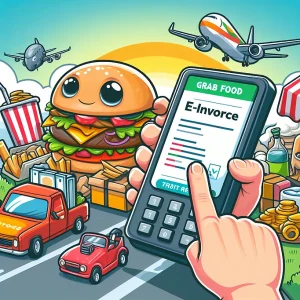For transactions that occur via an e-commerce platform like Grab Food, the e-commerce platform provider (in this case, Grab Food) is responsible for the issuance of e-invoices or receipts to the purchaser (the customer) for transactions concluded on the platform, such as the sale of goods or provision of services by your restaurant.
This means that for orders placed through Grab Food, the platform itself would handle the e-invoicing process directly with the customers.
When your restaurant issues a consolidated e-invoice at the end of the month for validation, this would typically cover transactions directly made with customers at your restaurant, not those made through the e-commerce platform.
The e-commerce platform provider would issue either an e-invoice upon the purchaser’s request or a receipt if no e-invoice is requested by the purchaser.

Furthermore, the e-commerce platform provider is allowed to aggregate transactions with purchasers who do not require an e-invoice on a monthly basis and submit a consolidated e-invoice to IRBM within seven (7) calendar days after the month-end.
This process is separate from the transactions directly handled by your restaurant.
Therefore, transactions occurring via the e-commerce platform like Grab Food would be accounted for and invoiced by the platform itself, and your restaurant’s consolidated e-invoice submission would focus on direct transactions not processed through the e-commerce platform.

Next, for transactions between your restaurant and Grab Food, the e-commerce platform (Grab Food) acts as an intermediary between your restaurant (the service provider) and the customers.
According to the e-Invoice Specific Guideline and FAQs, e-commerce transactions are defined as any sale or purchase of goods or services conducted over networks by methods specifically designed for receiving or placing orders.
The payment and ultimate delivery of the goods or services do not have to be conducted online.
In this context, when a customer orders food from your restaurant through Grab Food, the platform facilitates the transaction.

Based on the FAQs and Specific Guidelines, the responsibility for issuing an e-invoice or receipt to the customer for this transaction typically falls on Grab Food, as they are the platform provider directly interacting with the customer.
This is because the platform acts as the merchant’s (your restaurant’s) agent in these transactions, handling the order placement, payment processing, and sometimes even the delivery.
However, for the financial transactions between your restaurant and Grab Food (e.g., the settlement of funds, service fees, etc.), your restaurant would likely need to issue e-invoices for these transactions directly to Grab Food.

These transactions are considered B2B (business-to-business) and would involve the exchange of e-invoices between your restaurant and Grab Food for the services rendered and the commission or fees charged by Grab Food.
In summary, for customer orders placed through Grab Food, the platform is responsible for issuing e-invoices or receipts to the customers.
For the transactions between your restaurant and Grab Food, such as settlement of funds or service fees, your restaurant would handle the e-invoicing directly with Grab Food, adhering to B2B e-invoicing requirements.
Reference:
Frequently Asked Questions (FAQs) for e-commerce Industry

对于通过 Grab Food 等电子商务平台进行的交易,电子商务平台提供商(此处为 Grab Food)负责就平台上达成的交易(如您的餐厅销售商品或提供服务)向购买方(客户)开具电子发票或收据。
这意味着,对于通过 Grab Food 下达的购买单,平台本身将直接与客户处理电子发票开具流程。
当您的餐厅在月底开具合并电子发票进行验证时,通常会涵盖直接在您的餐厅与客户进行的交易,而不是通过电子商务平台进行的交易。
电子商务平台提供商会根据购买者的要求开具电子发票,或者在购买者没有要求开具电子发票的情况下开具收据。

此外,电子商务平台提供商可按月汇总与不需要电子发票的购买者的交易,并在月末后七(7)个日历日内向 IRBM 提交合并电子发票。这一过程与贵餐厅直接处理的交易是分开的。
因此,通过 Grab Food 等电子商务平台进行的交易将由该平台自行核算和开具发票,而贵餐厅提交的综合电子发票将侧重于未通过电子商务平台处理的直接交易。
其次,对于您的餐馆与 Grab Food 之间的交易,电子商务平台(Grab Food) 充当您的餐馆(服务提供商)与顾客之间的中介。
根据《电子发票特定指南和常见问题》,电子商务交易被定义为通过网络以专门用于接收或下订单的方法进行的任何商品或服务的销售或购买。
货物或服务的付款和最终交付不一定要在网上进行。

在这种情况下,当顾客通过 Grab Food 向您的餐厅订购食物时,平台会促成交易。
*向顾客开具电子发票或收据的责任通常由 Grab Food 承担,因为他们是直接与顾客互动的平台提供商。
这是因为该平台在这些交易中充当商家(您的餐厅)的代理,处理客户下的订单、付款处理,有时甚至是送货。
但是,对于您的餐厅和 Grab Food 之间的财务交易(如资金结算、服务费等),您的餐厅可能需要直接向 Grab Food 开具这些交易的电子发票。
这些交易被视为 B2B(企业对企业),涉及到您的餐厅和 Grab Food 之间就所提供的服务和 Grab Food 所收取的佣金或费用交换电子发票。
*总之,对于客户通过 Grab Food 下达的订单,平台负责向客户开具电子发票或收据。对于您的餐厅与 Grab Food 之间的交易,如结算资金或服务费,您的餐厅将直接与 Grab Food 处理电子发票事宜,并遵守 B2B 电子发票要求。






